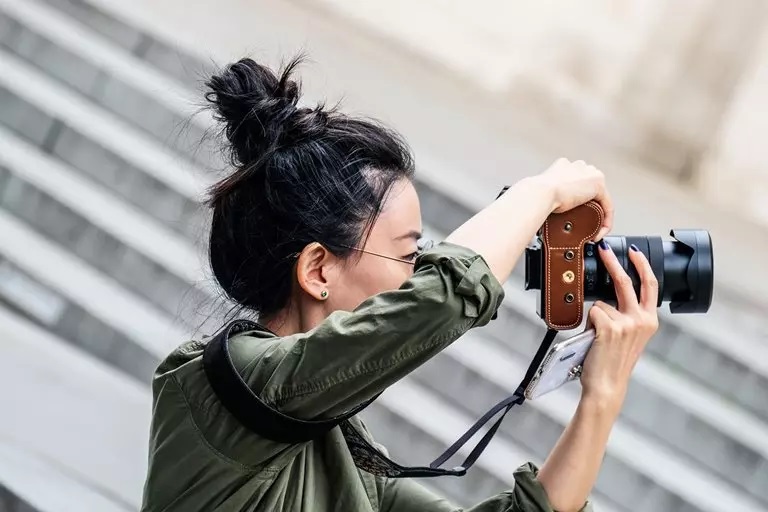Everything We Need To Know About Common Photographic Terms
You May Have Heard The Terms Photography Many Times; But Do Not Know Their Exact Use And Meaning. This Article Is A Comprehensive Overview Of The Most Common Photographic Terms.
Photographic terms You may sometimes come across seemingly complex words and phrases in photography forums or video tutorials. Usually, these terms are a bit confusing at first. To gain a deeper understanding of photography, it is best to become familiar with its common terms.
In this article, you will get acquainted with common photographic terms presented in alphabetical order.
Photography
It’s best to start with the word photography, which has an attractive background. The word “graph” is derived from the Greek word meaning light, and the word “graph” is derived from another Greek word meaning drawing.
As a result, the literal translation of the English word photography is drawing light. In this process, light is received through physical media such as film or microchip electronics to produce an image that can be stored, shared, and reproduced. Light is focused through the lens.
Lenses are a combination of several lenses that are specially adjusted to achieve a clear image.
AEB or Auto Exposure Bracketing
Photographers often aim to capture the image with the right exposure. An image that is neither too dark nor too bright. However, sometimes you may want to make changes to the photographic landscape; In this case, you can use AEB or bracketing.
With this method, you can capture good images in low or high light conditions. You can also later combine images into Lightroom or Photoshop and use the best part of each image to achieve the final image.
Aperture
Aperture means the amount of aperture of the camera lens. The wider the aperture, the less light you need to shoot or the shorter the shutter time to collect enough light. To better understand the concept of aperture, consider two buckets in the rain with a floor diameter of 10 cm.
The diameter of the upper part of one of the buckets is 10 cm, while the diameter of the other upper part is only one centimeter. Which bucket will be filled sooner? Definitely a bucket with a diameter of ten centimeters. The same is true for wider apertures. In this case, the light hits the lens faster.
To adjust the aperture on the camera, you need to see its number. The smaller the number, the better.
As a result, a lens with an aperture of f / 1.8 opens more than a lens with a maximum aperture of f / 4. If your aperture is in the range of f / 3.5-5.6, it means that the lens will open at a maximum off / 3.5 in the zoom mode and f / 5.6 in the zoom mode.

Aperture Priority
By setting the camera to Aperture Priority mode (Nikon A, A, and Canon Av), the camera automatically adjusts the shutter speed and ISO. Still, you can adjust the aperture to your liking.
Note: If the Auto-ISO mode is used, the camera automatically adjusts the ISO.
For example, if you want to take pictures of children with a blurred background and out of focus, you can set your camera to Aperture Priority, zoom your lens as far as possible, and set the aperture or f the lowest possible value. Now zoom in on the children or any other subject and capture the photo.
If you want to capture high-resolution images, you can also use the aperture priority mode. The difference is that you move your lens away and adjust the aperture value between f / 8 or f / 11 to get a large part of the image in Focus.

With aperture-priority shooting, you can select the appropriate aperture to your liking while the camera adjusts the shutter speed and ISO automatically.
Autofocus Points
Autofocus points are small points or squares that you see in the viewfinder. Some cameras have a large number of these points, and others have a small number of these points, but in general, the number does not matter. For example, if the camera is only 29 AF points and the other camera is 99 AF points, both can take good photos, although the second camera can provide more flexibility.
Depending on whether it is a portrait, landscape, action photography, animal photography, food, or anything else, the ability to select AF points can be advantageous. You can set your camera to use all AF points or focus with a specific set of points (area focus).
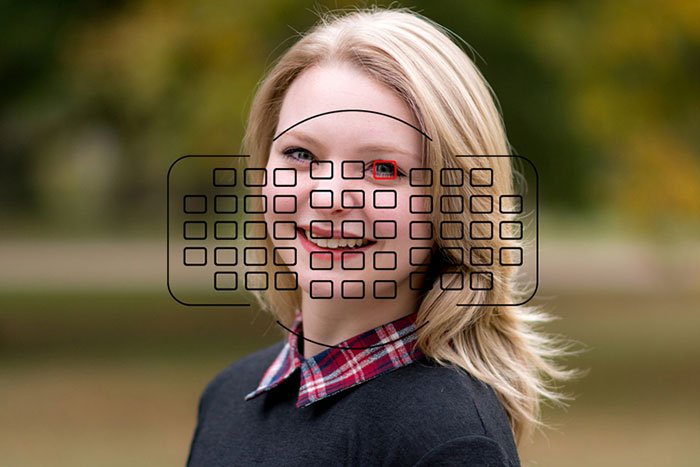
You can use the camera’s autofocus points to select specific points, such as the subject’s eye, in portrait photography.
Back Button Focus
On most cameras, you can adjust the focus of the subject by half-pressing the shutter button; But instead, you can adjust your camera to use the back button of the camera to do this. The button you feel with your thumb. This way, you can have more control over the photography. Sports photographers and night or portrait photographers often use this technique.
Bokeh
Bokeh is a name for areas out of focus or blur. Use a wide aperture to achieve maximum bokeh, get close to the subject, and ensure the subject is away from the background.
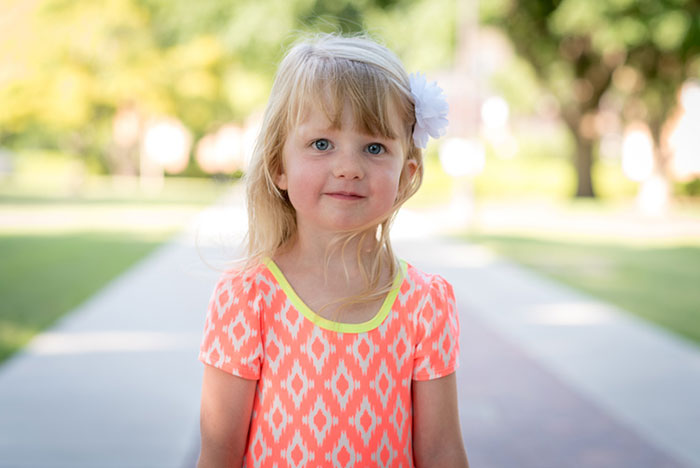
Bokeh refers to areas that are blurred and out of focus in the background (sometimes in the background).
Bulb Mode
You can use Bulb Mode for long exposures. In this case, pressing the shutter button opens the shutter camera and then closes it by releasing the key. You can use this mode for shooting with the remote control and make sure the camera does not shake.
Burning
Burning means selectively darkening parts of the photo. The term derives from the technique used for dark negatives, but today it can be easily done in Photoshop, Lightroom, or any other image processing software.
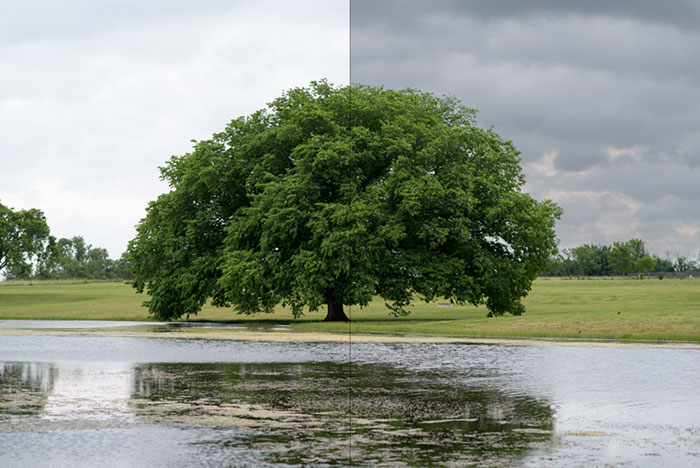
Left: This shows the main image, and the Burning technique is used to darken some areas and increase the contrast on the right side of the image.
Chimping
Chimping means a regular and unreasonable review of photos on the camera LCD screen. Of course, this habit is not very harmful, but it is better to stop this; Because you may be distracted from your surroundings and focus only on the screen. To break this habit, you can turn off your camera’s auto-browsing mode and check your images only when needed.
Chromatic Aberration
The camera lens works by focusing on the incoming lights. However, sometimes different colors of light show strange behavior due to the different structures of the lenses. This can lead to a phenomenon called color distortion. This happens in lenses and microscopes, telescopes, and other devices that deal with the lens.
If there is a color distortion, you may see streaks of purple or green at the edges of objects or blurred areas near the frame. This distortion manifests itself more in photography with wide apertures. Of course, this problem can be easily solved with tools such as Photoshop and Lightroom.
Clipping or Blinkies
Most images can be edited in Lightroom or Photoshop software; However, if parts of the image appear as blinking points, there is no data to edit these images.
This problem appears in the histogram at the far right. These sections usually have too much or too little exposure, so that they can not cover anything. This problem underscores the importance of exposing exposure to detail in some areas.
Composition
The term composition refers to the entire content of the image. The composition includes all the elements that are not in the image, the elements that are not there, the angle of the image, the focal length, the desired bokeh, and in general, all areas of the image.
Well-composed images have elements that interact to complete a photo or narrative: subject, foreground, background, and anything else that fits the other components of the image.
To achieve good composition, you can use guidelines to guide the eye to a specific part of the image. Good composition is time-consuming and requires practice, but also examining the work of photographers and other painters and illustrators can help achieve a good composition.

Composition refers to the whole image, not just the subject. Pay close attention to all image components, including light sources, background elements, and other elements such as guidelines, to achieve a good overall composition.
Crop Sensor
The physical size of the sensor in most cameras is smaller than a 35mm film. Hence they are called sensor crops. The size of crop sensors is usually 22 by 15 mm, while the size of full-frame sensors is 36 by 24 mm.
Sensor crop camera lenses behave relatively differently from full-frame cameras. Crop-sensor cameras are usually suitable for shooting in all situations unless you are a professional. You want to make money with your camera or need the highest image quality and the largest files. Otherwise, sensor crop cameras will suffice.
Depth Of Field
Depth of field in photography (sometimes spelled DOF or DoF) refers to the distance between the nearest and farthest objects in the scene, which changes in focus. The Depth of field is affected by several factors, including aperture, the lens’s focal length, distance to the subject, size of the film or digital sensor, and camera format.
If you have a subject in focus and another object in the foreground or background that is not in focus, a shallow depth of field will be obtained. When everything in the image is in focus, you have a wide depth of field.
Surface field depths are often used in portrait images because they highlight the subject and distinguish it from other parts of the image. Shooting at wide apertures helps you achieve a shallow depth of field, but be careful not to over-adjust the depth of field or distort your image (for example, the subject’s nose is in focus, but the eyes are out of focus).

You can see that part of the ground, and a flower is in focus, while other parts of the image are out of focus. This effect is called surface depth.
Dodging
Dodging means selectively turning on some parts of the image. The term, like Burning, is derived from techniques used in the darkroom, but today it can be easily done in Lightroom and Photoshop software.

Before Dodging

After dodging: A woman with a dark covering has become lighter without affecting other parts of the photo. Adjustment Brush in Lightroom is used for this technique.
DSLR
The term DSLR stands for Digital Single Lens Reflex. This term is used to describe cameras equipped with a mechanical mirror. This mirror is designed to direct the light entering the lens towards the prism and then the viewfinder. Clicking the shutter button moves the mechanical mirror, the aperture closes according to the selected settings, the shutter opens for exposure to the sensor, and the image is captured.
The mirror returns to the starting point after the exposure is complete. All of this happens in the blink of an eye.
Before the advent of DSLR cameras in 2005, most cameras used film and were called SLRs or telescopic reflectors. Today, some people prefer to use mirrorless cameras that do not have a mechanical mirror.
Mirrorless camera output is just as good as DSLRs. Both types of cameras have advantages, and you should buy the camera according to your needs.

Dynamic Range
The dynamics of suffering is the difference between the brightest and darkest parts of a photo. It is also called the contrast range. The dynamic human eye has extraordinary suffering to see very bright and very dark objects simultaneously.
If you stand in a room and look out the window on a sunny day, you will see the sky in light blue. In this case, you can see the objects in the room with good resolution.
Cameras also usually see and record very bright or very dark areas, but they cannot simultaneously. For example, from a window, the camera looks like objects outside the window, but objects inside the room look dark, or vice versa, while the outside view is much brighter than the room.
Modern digital cameras are still far from the eye, but they suffer more dynamically than older models.
These cameras have improved exposure adjustment. On the other hand, with computer software, you can restore many details of dark areas.

Main picture

The original image (above) is completely dark, but the camera sensor has recorded more data. With RAW shooting, you can correct a lot of information about dark areas in Lightroom.
Exposure
Exposure is the sum of the light entering the sensor for a frame or a shot. Exposure can be calculated with exposure triangle settings: ISO, aperture, and shutter speed. Photographers often argue about low or high exposure, and it can almost be said that the quality of the output depends on the proper exposure.
Exposure in the general sense means the amount of light or darkness in an image, and although some images have very light and very dark parts, the whole discussion falls under the umbrella of the term exposure.
By pressing the shutter button on the camera, you are actually exposing the sensor.
The amount of light input also depends on the aperture of the lens, the shutter retention time, and the ISO sensitivity of the camera’s digital sensor.

With proper exposure, the image is neither too dark nor too bright. Sometimes photographers intentionally capture low- or high-exposure images for artistic reasons.
Exposure Compensation
Exposure compensation is a way to quickly adjust the image’s brightness when shooting in semi-automatic modes, such as Aperture Priority, Shutter Priority, or Program Auto.
If the image captured on the screen (or histogram) looks too bright, you can use Exposure Compensation to adjust the exposure. Adjusting this value to a negative value such as 1- or 2- will make the next image appear darker. The same principle can be applied to higher values and brighter subsequent images.
Note: Reset Exposure Compensation to zero when done. Otherwise, the rest of your images may be too dark or too light.
F-Stop or F-Number (F-Stop, F-Number)
F-stop, or F-number, is a scale for measuring the amount of light entering through an aperture. This scale is calculated by dividing the focal length of the lens by the diameter of its aperture. To better understand this scale, consider the following example:
Slight opening
- Lens: 100 mm
- Diaphragm Valve Diameter: 10mm (The smaller it is, the less light enters)
- As a result, the number f is equal to f / 10
More opening
- Lens: 100 mm
- Diaphragm Valve Diameter: 50 mm (the larger the diameter, the more light enters)
- As a result, the number f is equal to f / 2
Suppose you cut a pizza into ten slices. One-half of pizza is definitely more than one-tenth of pizza. The lens works the same way. F / 2 allows more light to enter than f / 10. A smaller F-stop like f / 1.8 means you’re shooting with a wide aperture, so more light enters the camera, and a larger F-16 like f / 16 indicates a smaller aperture and less light entering the camera.
Lenses with low F-stop values are suitable for low light situations because they allow more light to enter so that you can shoot even without the need for a flash.
A lower amount of F-Stop also produces a bokeh or tartar background.
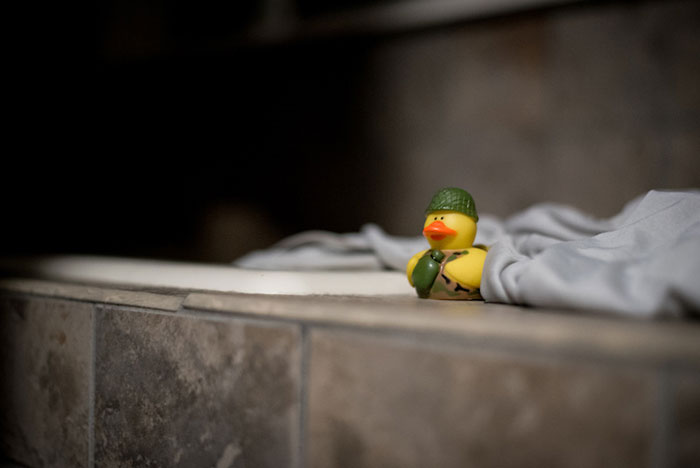
This image was recorded in the early hours of the morning with very little light. For this image, f-stop f / 1.8 was used to allow more light to hit the lens.
Fill Flash
You can help improve the subject’s shadows by using the built-in flash or the external flash. This flash is a filler and is especially useful when light shines from behind the subject, such as when the sun faces the sun.
If you shoot in Auto mode, you can not turn on the flash. In this case, try to put the camera in Program mode to control the flash.
Full Frame
Unlike sensor crop cameras, full-frame camera models have a video sensor the same size as a 35mm film. These cameras are usually more expensive and have better image quality at higher ISOs. Lenses for full-frame cameras are also of higher quality.
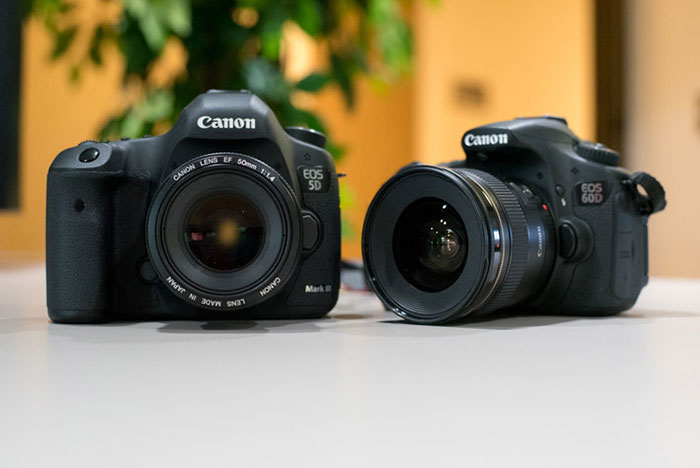
The Canon 5D Mark III is a full-frame camera, while the Canon 60D is a crop sensor.
Histogram
You can see the histogram on the camera or in the computer editing program. This graph shows exactly where your image data is very light (on the right) or very dark (on the left). If the histogram has a mountain-like appearance, the photo has the correct exposure, but if it resembles a valley with two mountains around it, there are probably too many bright spots or too many dark spots in the photo.
If the histogram is raised in a chart layout, other sections may be too dark or too bright, so you may not be able to retrieve data from these points in Photoshop or any other program.

Hyperfocal Distance
A superficial distance is simply the focal point at which the image has the maximum depth of field. The exact superficial distance depends on several variables, such as the lens’s focal length, the size of the aperture or off-stop, and the distance between the subject and the camera. There are applications and diagrams for calculating the maximum depth of field and superficial distance.
ISO
ISO refers to the sensitivity of a camera sensor to light. Shooting at low ISO values such as 100, 200, or 400 in high light conditions is recommended. High ISO photography such as 1600 or 3200 in low light conditions or if you do not want to use the flash is also recommended.
Some people believe that shooting with higher ISO values will increase the image noise, but you can increase the ISO if you do not want to print your photo.
Note: Technically, increasing the ISO does not increase the image sensor’s sensitivity but increases the absorption of the sensor. However, it is important here that when shooting with ISO 100, you need more light and proper exposure.
The image below is recorded with the Nikon DSLR at ISO 3200. If you zoom in on the image, you can see the digital noise.

JPG, JPEG
There are several image formats such as PNG, TIFF, BMP, GIF, and many more, each with its own advantages and disadvantages. Fortunately, all camera manufacturers use the standard JPG format, which has been around since 1991.
Although this format has many drawbacks, its widespread use has made it a standard for today’s photos. JPG images do not take up much space on the computer; they are acceptable in quality and can even be edited in Photoshop or mobile phones.
On the other hand, jpg files such as TIFF or PNG formats do not hold much data, so due to the algorithm used to reduce the image size, there is a possibility of pixelation or blurring of sharp edges the image.
If you are looking for smaller files with easier sharing, you can use jpg format, but you can use formats like RAW if you look for more flexibility in image editing.
Kelvin
Just as the air temperature is measured in degrees Fahrenheit or degrees Celsius, white balance is measured in degrees Kelvin. Bright sunlight is about 5,000 Kelvin, while artificial fluorescent light is about 2,700 Kelvin. By knowing the lighting conditions, you can adjust the white balance or use the camera’s automatic white balance mode.
Kit Lens
The kit lens is a standard lens that comes with most DSLR cameras. These lenses are almost universal, but they can not be used professionally for a specific purpose. Many people love kit lenses and have been using them for years, But some photographers also prefer more expensive lenses designed for a specific purpose.
If you have a lens kit, you can also buy other lenses such as 35mm or 50mm Prime lenses; But if the kit lens meets your needs, you do not need to buy another lens.
One of the reasons for the low price of kit lenses is that these lenses are made of plastic parts instead of metal and do not have sufficient resistance to all kinds of weather or dust, and also cover a smaller aperture due to the structure of the lens components. Despite these limitations, kit lenses are useful for beginners.

This image was taken with a Canon XT1 camera with an 18-55mm lens at 18mm and f / 8.
Lens Flare
A flare lens is simply a reflection of light that strikes the subject in front of the lens. Feller lenses appear in some images as spots or beams of light. Some people like flair lenses, and others consider it an extra element and a misleading factor, but flare lenses can give a softer and more natural look to the image.
Expensive lenses have a special lens coating to reduce the flared lens. Many lenses are also equipped with a lens hood that can prevent excess light from hitting the lens.

Macro Photography
Macro means “large,” and a macro lens can magnify small objects and subjects, such as insects or the petals of flowers. Technically, a macro lens can produce a one-to-one ratio on the sensor. A 1 cm diameter coin from the macro lens occupies a 1 cm circle on the camera sensor. In fact, the coin fills the entire frame. Macro lenses allow you to shoot very close up compared to other lenses.
Also, Macro lenses are expensive, but they produce great images, and if you want to take macro shots at no extra cost, you can use tube extensions, close-up filters, or even clip-on lens attachments for your smartphone.

Macro style photography; Whether you use a macro lens or lens accessories, this style of photography and its angle of view is an engaging and fun experience.
Megapixels
A megapixel is the resolution of a digital sensor or the number of independent dots (pixels or image components) that make up a digital image. Megapixels are calculated by multiplying the number of width pixels by the number of height pixels. For the Canon 1DX, for example, this is 5,184 ۴ 3456 = 17.9 million (18 megapixels effective).
In any case, when buying a camera, it is better not to pay much attention to its megapixels. It is widely believed that more megapixels mean higher quality, while this is not true. The Canon 1DX is only 18 megapixels.
The Sony A7S has only 12 megapixels. Smartphone cameras are between 6 and 12 megapixels, although the megapixels have increased dramatically on newer models, and most non-professional cameras also have between 16 and 24 megapixels. Cameras made with high megapixels are not necessarily of better quality.
![]()
This photo was taken with the Canon PowerShot SD10 pocket camera, which has only 3 megapixels.
Micro Four Thirds
Competition is useful, but it can sometimes lead to stressful situations. This kind of competition can be seen between Canon, Nikon, Pentax, Sony, Fuji, and other camera brands. Every company has a set of lens standards. In 2008, Panasonic and Olympus teamed up to develop a new mirrorless camera with a small sensor compatible with any lens. This system is called micro four-thirds (MFT).
The micro four-thirds system refers to the small image sensor and the width-to-length ratio.
On the other hand, the third micro-quarter was confusing for some users; But do not listen to hate speech on the Internet. MFT cameras are small and lightweight cameras and, like other cameras, perform well.
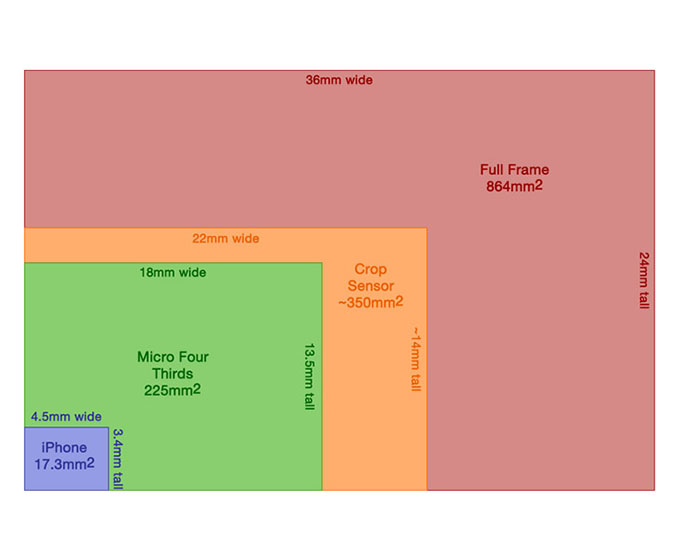
Camera sensors come in various sizes, and as you can see, the micro four-thirds sensor is not much smaller than the sensor of most DSLR sensor crop cameras. There is not much difference in everyday photography. The important thing is the quality and output of the image.
Mirrorless Cameras
All Canon or Nikon DSLR cameras have a small mirror the size of a postage stamp. The mirrors are at a 45-degree angle and reflect light from the lens to the prism and then to the viewfinder. The mirror rotates by pressing the shutter button, and the camera can send light to the sensor.
Fuji, Sony, Panasonic, Leica, Nikon, Canon, Pentax, Sigma, and Olympus also produce mirrorless cameras. These cameras have a relatively smaller body but function quite similarly to DSLR models.
Some mirrorless cameras are micro four-thirds. If someone tells you that a mirrorless camera is weaker than a DSLR camera, just nod your head politely and smile. Then enjoy your mirrorless camera while you know how misleading your friend is.
ND or NEUTRAL DENSITY FILTER
ND stands for Neutral Density and can block some incoming lights. Longer exposures can be achieved with the ND filter. You may have seen pictures of a river or waterfall in which the water looks soft and silky. ND filters are commonly used to capture these images, so the photographer can hold the shutter open for a few seconds, even in daylight.
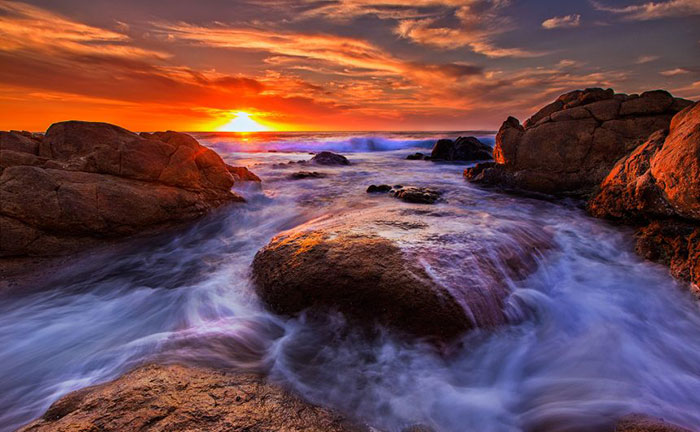
Nifty Fifty
For many years, 50mm lenses have been known as standard focal length lenses; Because they are neither too long (telephoto) nor too wide (wide). These lenses are usually small, lightweight, and relatively inexpensive.
For this reason, these lenses have been nicknamed Nifty Fifty or Fifty Attractive and are highly recommended for a variety of shooting scenarios.
Noise
If you capture images at very high ISOs such as 3200 or 6400 and then see the images on a computer screen, you will come across funny spots and patterns on the images that look like the screens of old TVs. These patterns are called digital noise.
Noise is a big problem for digital cameras, but today technology offers good solutions to this problem.

This image is recorded at ISO 6400 and looks good in zoom mode. With 100% magnification, you will see several spots that are the same as noise. You can remove these noises using Photoshop or Lightroom.
Pixel Peeping
If you zoom up to 100% on the camera screen or with the Photoshop or Lightroom magnifying glass tool, you may find errors in your images. For example, one of the eyelashes is blurred, and the leaf of the tree has disappeared. Paying too much attention to pixel detail is called piping. In general, avoid spending too much time on details and enjoy photography.
Fixed focal length lens or Prime (Prime Lens)
Prime is a type of lens that has no zoom and zoom with a fixed focal length. Most zoom lenses have a smaller aperture, so they can’t absorb as much light as prime lenses. On the other hand, prime lenses have a larger aperture.
As a result, fixed or prime lenses can be used for shooting in low-light situations, and there is no need to use a flash. These lenses also help to create a bokeh effect in the background of portrait photos. Prime lenses are also smaller and lighter than zoom lenses.
If you use a kit lens on your camera and try a new lens, you can use 35mm or 50mm Prime lenses.

Prime lenses are not able to magnify; These lenses have wider apertures and showcase creative shooting techniques.
Program Mode
The letter P on the camera stands for Program Mode. This mode is a combination of Aperture Priority and Shutter Priority modes. In this mode, the camera selects the appropriate aperture, shutter, and ISO values for exposure. Of course, you can change these settings slightly by adjusting the aperture and shutter simultaneously.
Working with Program mode is fun, and if you look closely at the F-stop and shutter numbers in the viewfinder, it helps you understand the types of outputs from these changes. Using the P mode, you can access other custom features such as white balance, flash or select different focus modes.
Raw Format
When shooting with any type of camera, whether DSLR or smartphone, the photosensor captures various light and color data and then deletes large amounts of this data to create a small JPG file, however, if you are looking for a high-quality image and have complete control over your images, it is better to shoot in RAW mode.
This way, no data is lost, and you can edit the entire content of your photo in Photoshop, Lightroom, or any other program. Raw images (RAW) take up a lot of space and may quickly fill your memory card. These images are not easy to share, but many photographers prefer them because they have a lot of flexibility in editing.
Flash Sync (Rear Curtain Sync)
Light travels at high speed. When working with Flash, you usually have two options: Activate the flash when the shutter is opened (default settings) or just before it closes. The second option is called flash synchronization. This technique can have a significant effect on the output image.
Remote Triggers
The remote control is a simple device that connects to the camera and allows remote control. The wireless version of this device sends a radio signal to the camera. This feature is great if you do not want to get too close to your camera.
Wildlife photographers use these facilities to photograph wildlife. These devices are a great way to minimize vibration, even on a tripod. Many professional photographers also use remote controls to direct side flashes or the speed of light.
Sensor
The sensor is right inside the camera. This is a small, flat microchip the size of a postage stamp, which usually has the same functionality as a film on older cameras. The main purpose of the sensor is to collect light, especially the light entering through the lens.
Smartphones and pocket cameras have tiny sensors, while more expensive cameras with interchangeable lenses have larger sensors. In general, smaller sensors are not very suitable for shooting in low light situations, so sometimes it is necessary to use flash for shooting with a pocket camera or smartphone. In general, more expensive cameras have larger sensors.
However, a camera with a larger sensor does not necessarily make you a better photographer.
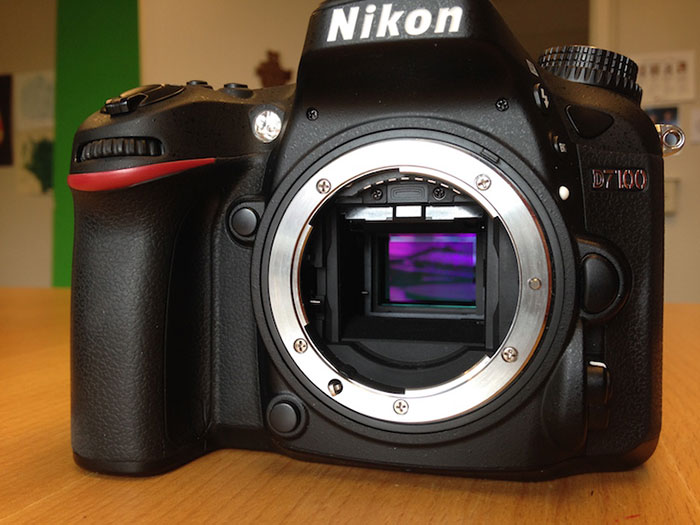
The purple square in the middle of the camera is the same sensor. A microchip that absorbs incoming light. In previous years, the film piece did this.
Shooting Wide Open Photography
When you use the widest aperture possible for the lens, this is called wide open shooting. You do not need a portrait lens to do this, and any lens with a maximum and minimum aperture can be used.
Shutter
The shutter is a tiny door or curtain inside the camera that opens and closes to light. In most cameras, the shutter works just like a house window. The maximum shutter speed on most cameras is 1.4000 seconds.
At this speed, the fastest subjects, such as skaters or surfers, can be photographed. You need a lot of light to shoot at such a high speed, but you can easily achieve good results if you shoot during the day.
Shutter Priority
Shutter priority mode is available on most cameras. In this case, you can only adjust the shutter speed manually, and other settings such as ISO and aperture are the responsibility of the camera. This feature is useful when you do not care about the depth of field and just want to freeze the moment or so-called freeze or create a sense of time.
Use a shutter speed of 1.500 or 1.000 seconds to freeze for a moment, and you need slower speeds such as ten to twenty seconds to create a sense of time. Set your camera to shutter priority mode (Nikon S, Tv, or Canon Time value), then set the desired speed. The camera does the rest.
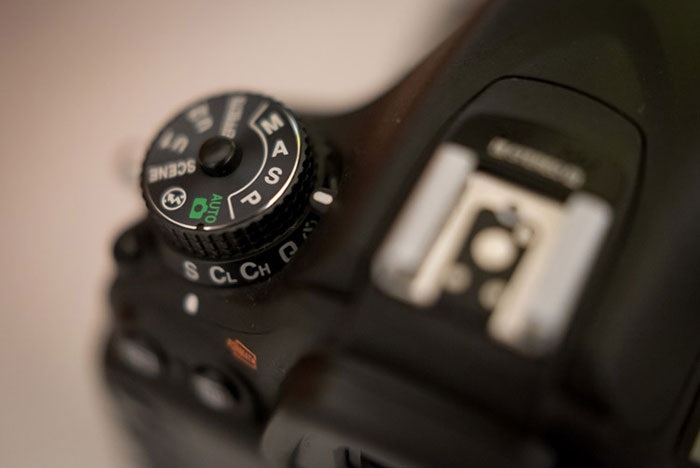
In shutter priority mode, you only need to adjust the shutter speed manually, and the rest is up to the camera.
SOOC
SOOC stands for Out-of-Camera and refers to images that the photographer has not edited in Photoshop, Lightroom, or any other program.
Speedlight
Speedlight is a type of flash that attaches to the camera. The built-in flash on most cameras is tiny and does not emit much light, but speed lights have enough power to illuminate even the darkest rooms. Disadvantages of Speedlight include high cost, high weight, and battery consumption.
Sync Speed
Sync speed is the fastest shutter speed you can use when shooting with a flash to prevent light cuts. Just shoot at the recommended sync speed for your camera (most speeds are 1.200 or 1.250 seconds). You can also use slower shutter speeds, but you will need to apply more sophisticated techniques and settings at higher shutter speeds.
Telephoto Lens
The term telephoto lens refers to lenses with a longer focal length than normal. The normal focal length on a full-frame sensor is usually 50 mm. There is a lot of talk about the focal length of a telephoto. Still, it is usually known as 85mm short telephoto, 125mm medium telephoto, and any distance greater than 200mm telephoto.
TTL and E-TTL flash metering
Most cameras and flashes work with a system called TTL metering, which stands for in-lens metering. You may have encountered the term E-TTL, which stands for Evaluation In-Lens Metering, and A-TTL, which stands for Advanced In-Lens Metering.
The camera measures the appropriate input light during exposure with TTL flash metering and deactivates the flash assuming proper exposure. In A-TTL and E-TTL modes, the camera prioritizes flash before exposure.
It then measures and uses the power of the flash-based on the appropriate exposure. As a result, by shooting in E-TTL mode on the flash and assuming an aperture of f / 5.6, the pre-flash mode sends out a light, the camera measures the light beam and adjusts the flash above or below the amount of light received.
Vignette
The word vignette is derived from a French word meaning small vine. The term refers to the design of trees or vines in the image’s margins that separated the book’s chapters. Today, this combination is used for dark areas that sometimes appear in the margins of photos.
Sometimes this effect depends on the physical aspect of the lens and the curvature and formation of light in them, especially when shooting wide-angle in full-frame cameras. Still, sometimes it can be artificially added to photos with software such as Lightroom, Apple Photos, or simple Instagram filters. کرد.
If you are looking to use a vignette, try to do it very subtly. Exaggeration in any effect, especially vignette, can give the image an old-fashioned feel.
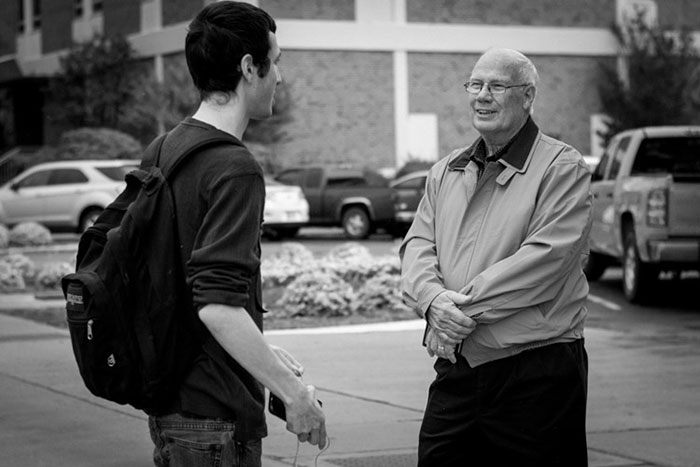
The vignette effect is used to darken the image’s margins and draw the audience’s attention to the two men in the middle of the image.
Weather-Sealed
Some cameras are designed with more resistance. Although most cameras are high-strength today, models like the Canon 1DX, Nikon D5, Fuji X-T1, and XT-2 or Pentax K1 can be quite resistant to many of nature’s forces.
These cameras survive dust, dirt, water, electricity, extreme heat, cold, or even the destructive hands of children. This resistance is thanks to special seals, insulators, and components made of magnesium alloy or carbon fiber.
Note: Weather resistance does not necessarily mean that the camera is waterproof. Olympus and many other brands have designed waterproof cameras for underwater photography.
White Balance
White balance simply means adjusting the color shade of images so that the image and landscape look neutral or in proportion to the actual colors. Multiple color sources produce different lights (with different temperatures or light colors), so the camera has settings to adjust the surroundings. These settings are called white balance settings.
Most cameras have white balance defaults (including Auto or AWB) that come with visual cues to help you adjust the white balance to various shooting positions. Common settings are daylight, cloudy, shade, fluorescent, flash, and tungsten or incandescent. You can also shoot in RAW format, which allows you to adjust the white balance on your computer with Lightroom and Photoshop.
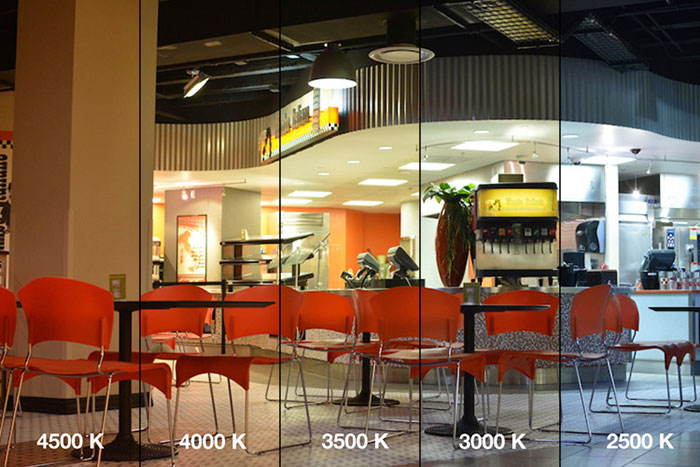
The same scene with different white balance settings. Each of these settings gives the photo a different look that comes with light color changes.
Wide Angle Lens
A wide-angle lens is a lens with a shorter focal length than normal (50 mm on a full-frame sensor). Nature and landscape photographers are Peruvian fans of wide-angle lenses because they can capture wide and open landscapes and spaces. Ultra-wide lenses (wider than 24mm on the full-frame) are ultra-wide lenses. Fisheye lenses are wider and have a focal length of more than 15 mm.
Concluding remarks
We hope the above definitions have helped you improve your understanding of the camera and the photographic process. If you are confused by this information, try to find and check it on your camera. The more you work with shutter speed, white balance, or depth of field, the easier it will be to understand these concepts.
Don’t worry about memorizing all the concepts, and you will memorize them over time as your photography skills and experience increase. The only way to improve your photography skills is to go out and take pictures.












